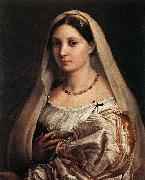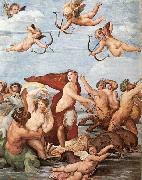
|
Artists
Index
|
||
|
RAFFAELLO Sanzio
|
||
|
Woman with a Veil new21/RAFFAELLO Sanzio-837396.jpg Painting ID:: 63780 |
1516 Oil on canvas, 82 x 60,5 cm Galleria Palatina (Palazzo Pitti), Florence Tradition identifies the subject with "la Fornarina", the woman whom the painter loved in his last years and whose face reappeared in both his paintings (e.g. in the Sistine Madonna) and those of his followers. However, the woman, has never been decisively identified. She seems to represent Raphael's ideal of beauty at this time. The painting shows greater attention to colour and to the rendering of skin and clothes in respect to previous female portraits. The regular oval of the young woman's face stands out against the dark background and her eyes hold an intense and penetrating look. The silk of her sleeves contrasts with her ivory-like skin, and is closely associated with the thin pleating of the dress, held up by a corset with golden embroidery. As in the portrait of Castiglione, the figure radiates a sense of great dignity and restraint. But greys and light-blues dominated the portrait of Castiglione: here the warm tonalities of white and gold take over. Raphael is preparing the wider colour range and the more complex composition which will be expressed in the Portrait of Leo X.Artist:RAFFAELLO Sanzio Title: Woman with a Veil (La Donna Velata) Painted in 1501-1550 , Italian - - painting : portrait | |
| |
|
|
|
|
||
|
Madonna dell'Impannata new21/RAFFAELLO Sanzio-379685.jpg Painting ID:: 63781 |
1513-14 Oil on wood, 158 x 125 cm Galleria Palatina (Palazzo Pitti), Florence In the mid-1510s Raphael had passed from the highly synthetic and expressive compositions of the first years of the decade to representations which were more and more complex and even more dispersive. Most of these were also finished by his pupils, for this was the busiest moment in Raphael's career. The Madonna dell'Impannata in the Pitti Gallery in Florence was also painted with the help of assistants. According to some critics, the assistants executed the entire painting. But others see the master's hand at least in the major figures (some say in the Christ Child, some in St Elizabeth, some in both figures). The composition is innovative in respect to the usual iconography of the holy family. It shows St Catherine, St Elizabeth, Christ, the Virgin and St John gathered together in a group. A large tent is visible in the background and a window covered by linen (the impannata, or cloth covering of a window, which gives the painting its name) can be seen at the extreme right. Like many other works by Raphael, this painting was carried off by the French in 1799 and was not returned until after the Congress of Vienna, in 1815.Artist:RAFFAELLO Sanzio Title: Madonna dell'Impannata Painted in 1501-1550 , Italian - - painting : religious | |
| |
|
|
|
|
||
|
Portrait of Jeanne d'Aragon new21/RAFFAELLO Sanzio-957392.jpg Painting ID:: 63782 |
1518 Oil on wood transferred to canvas, 120 x 95 cm Mus?e du Louvre, Paris The painting was commissioned by Cardinal Bibbiena. It was intended as a gift for Francis I, King of France. It was executed by one of Raphael's pupils, perhaps on the basis of a design by Raphael. The painting was restored in 1540 by Primaticcio in Fontainebleau, after the restoration it was transferred from wood to canvas.Artist:RAFFAELLO Sanzio Title: Portrait of Jeanne d'Aragon Painted in 1501-1550 , Italian - - painting : portrait | |
| |
|
|
|
|
||
|
The Triumph of Galatea new21/RAFFAELLO Sanzio-425729.jpg Painting ID:: 63783 |
1511 Fresco, 295 x 225 cm Villa Farnesina, Rome The Sienese Banker, Agostini Chigi, played a very important role in the cultural and artistic activities which flourished around Julius II. His house was built on the outskirts of Rome in 1509-1510, and was designed as a model of luxury and elegance. He commissioned the most famous artists of the time, Baldassarre Peruzzi, Sebastiano Luciani (later called Sebastiano del Piombo) and Raphael himself to decorate it. All three painted frescoes based on classical mythology in Chigi's house (which was later acquired by the Farnese family and came to be known as "La Farnesina"). As subject Raphael chose a verse from a poem by the Florentine Angelo Poliziano which had also helped to inspire Botticelli's 'Birth of Venus'. These lines describe how the clumsy giant Polyphemus sings a love song to the fair sea-nymph Galatea and how she rides across the waves in a chariot drawn by two dolphins, laughing at his uncouth song, while the gay company of other sea-gods and nymphs is milling round her. Raphael's fresco shows Galatea with her gay companions; the giant is depicted in a fresco by Sebastiano del Piombo which stands to the left of Raphael's Galatea. However long one looks at this lovely and cheerful picture, one will always discover new beauties in its rich and intricate composition. Every figure seems to correspond to some other figure, every movement to answer a counter-movement. To start with the small boys with Cupid's bows and arrows who aim at the heart of the nymph: not only do those to right and left echo each other's movements, but the boy swimming beside the chariot corresponds to the one flying at the top of the picture. It is the same with the group of sea-gods which seems to be 'wheeling' round the nymph. There are two on the margins, who blow on their sea-shells, and two pairs in front and behind, who are making love to each other. But what is more admirable is that all these diverse movements are somehow reflected and taken up in the figure of Galatea herself. Her chariot had been driving from left to right with her veil blowing backwards, but, hearing the strange love song, she turns round and smiles, and all the lines in the picture, from the love-gods' arrows to the reins she holds, converge on her beautiful face in the very centre of the picture. By these artistic means Raphael has achieved constant movement throughout the picture, without letting it become restless or unbalanced. It is for this supreme mastery of arranging his figures, this consummate skill in composition, that artists have admired Raphael ever since. Just as Michelangelo was found to have reached the highest peak in the mastery of the human body, Raphael was seen to have accomplished what the older generation had striven so hard to achieve: the perfect and harmonious composition of freely moving figures. There was another quality in Raphael's work that was admired by his contemporaries and by subsequent generations - the sheer beauty of his figures. When he had finished the 'Galatea', Raphael was asked by a courtier where in all the world he had found a model of such beauty. He replied that he did not copy any specific model but rather followed "a certain idea" he had formed in his mind. To some extent, then, Raphael, like his teacher Perugino, had abandoned the faithful portrayal of nature which had been the ambition of so many Quattrocento artists. He deliberately used an imagined type of regular beauty. If we look back to the time of Praxiteles, we remember how what we call an "ideal" beauty grew out of a slow approximation of schematic forms to nature. Now the process was reversed. Artists tried to modify nature according to the idea of beauty they had formed when looking at classical statues - they "idealized" the model. It was a tendency not without its dangers, for, if the artist deliberately "improves on" nature, his work may easily look mannered or insipid. But if we look once more at Raphael's work, we see that he, at any rate, could idealize without any loss of vitality and sincerity in the result. There is nothing schematic or calculated in Galatea's loveliness. She is an inmate of a brighter world of love and beauty - the world of the classics as it appeared to its admirers in sixteenth-century Italy.Artist:RAFFAELLO Sanzio Title: The Triumph of Galatea Painted in 1501-1550 , Italian - - painting : mythological | |
| |
|
|
|
|
||
|
The Sibyls new21/RAFFAELLO Sanzio-576275.jpg Painting ID:: 63784 |
1514 Fresco Santa Maria della Pace, Rome The detail shows the Tiburtine Sibyl.Artist:RAFFAELLO Sanzio Title: The Sibyls (detail) Painted in 1501-1550 , Italian - - painting : religious | |
| |
|
|
|
|
||
| Next artist | ||
|
Also Buy::. For Following Paintings / Artists / Products, Please Use Our Search Online: |











